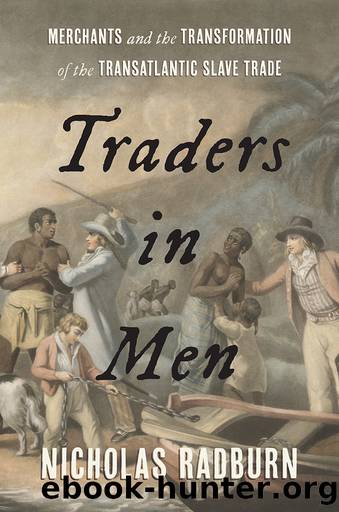Traders in Men by Nicholas Radburn

Author:Nicholas Radburn
Language: eng
Format: epub
Publisher: Yale University Press
Published: 2023-07-15T00:00:00+00:00
Figure 5.2. The sale of 333 enslaved people from the Marie-Séraphique, Saint-Domingue, c. 1773. From Jean-René LâHermite and Jean-Baptist Fautrel-Gaugy [?], Vue du Cap Français et Du Navire La Marie Séraphique de Nantes Capitaine Gaugy Le Jour de lâOuverture de sa Vente Troisième Voyage DâAngole 1772, 1773. Reproduced with permission of the Château des ducs de Bretagne, Musée dâhistoire de Nantes.
A painting of the sale of 333 people from the Marie-Séraphique at Cap Français, Saint-Domingue, on January 14, 1773, depicts how these opening stages of American sales occurred (Figure 5.2). Buyers are being ferried out to the vessel from shore and are ascending a set of stairs leading to the main deck. The ship is still divided in two by the barricado, with men slaves on the main deck and women on the quarterdeck, where the factor and captain are stationed beneath an awning. Numerous male colonists are shown carefully selecting from the naked male captives on the main deck: buyers can be seen approaching individuals, touching their faces, making them raise their arms in the air, and holding their handsâclearly inspecting them closely. On the other side of the barricado, female colonistsâincluding women of colorâare simultaneously examining enslaved women. Groups of Africans chosen from the deck are seated by the side of a table laid out with a lavish meal while their purchasers negotiate with the captain and factors over prices and terms of credit. A boat in the foreground rows a group of purchased Africans away from their shipmates; their new master is shielded from the sun by a large parasol. This unique image thus powerfully captures the African experience of sale in the Americas: humiliating inspection by large numbers of white colonists followed by forced separations from most shipmates.30
In the saleâs second stage, middling planters, town dwellers, and merchants entered the sale to purchase what Ramsay called the âsecond days slavesââthe elderly, sickly, and adolescent captives left after the richest planters had made their purchases. Although Ramsayâs grim label suggests that this phase occurred on the second day, it actually took place whenever the healthiest captives had been sold, and often at the same time. When Thomas Thistlewood tried to enter a slave sale on its first day in August 1776, for example, he was accompanied by Mary Cope (b. 1736), the wife of his employer, who sought a âgirl, about 12 years of age,â who could be trained as a seamstress and gifted to her daughter Peggy. As this account reveals, healthy children were particularly apt to be sold at this stage, as colonists sought young people who could be apprenticed in a trade or put into domestic service. Planters sometimes sought teenage boys in this stage of the sale, as they could work for the remainder of their adult lives, often in skilled positions. When the managers of a Jamaican sugar estate wanted people trained for the âCarpenters Businessâ in 1785, for example, they purchased âthree very likelyâ boys, who were then apprenticed to a white carpenter for five years.
Download
This site does not store any files on its server. We only index and link to content provided by other sites. Please contact the content providers to delete copyright contents if any and email us, we'll remove relevant links or contents immediately.
| Anthropology | Archaeology |
| Philosophy | Politics & Government |
| Social Sciences | Sociology |
| Women's Studies |
Nudge - Improving Decisions about Health, Wealth, and Happiness by Thaler Sunstein(7471)
iGen by Jean M. Twenge(5334)
The Fire Next Time by James Baldwin(5207)
Adulting by Kelly Williams Brown(4445)
The Hacking of the American Mind by Robert H. Lustig(4271)
The Sports Rules Book by Human Kinetics(4222)
The Ethical Slut by Janet W. Hardy(4153)
Captivate by Vanessa Van Edwards(3772)
Mummy Knew by Lisa James(3590)
In a Sunburned Country by Bill Bryson(3457)
The Worm at the Core by Sheldon Solomon(3401)
Ants Among Elephants by Sujatha Gidla(3369)
Suicide: A Study in Sociology by Emile Durkheim(2953)
The Slow Fix: Solve Problems, Work Smarter, and Live Better In a World Addicted to Speed by Carl Honore(2918)
The 48 laws of power by Robert Greene & Joost Elffers(2899)
Humans of New York by Brandon Stanton(2751)
Handbook of Forensic Sociology and Psychology by Stephen J. Morewitz & Mark L. Goldstein(2642)
The Happy Hooker by Xaviera Hollander(2631)
The Tipping Point by Malcolm Gladwell(2627)
